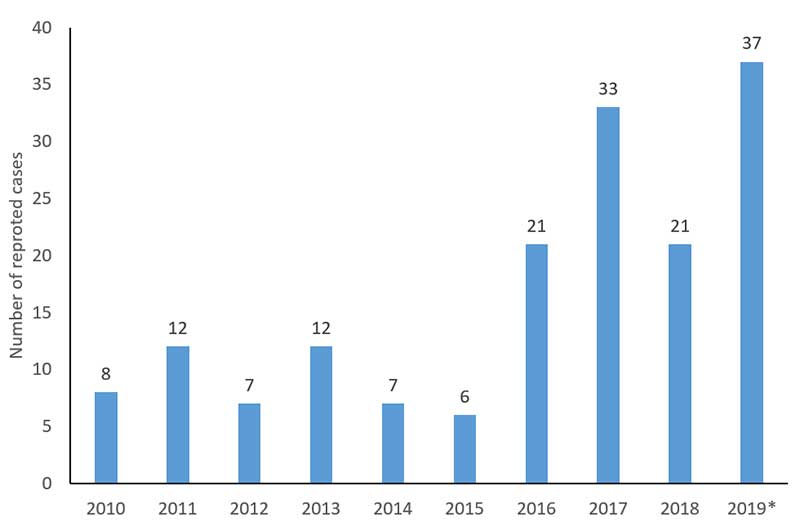
Powassan Virus
What is Powassan Virus?
Powassan virus is a flavivirus, related to some mosquito-borne viruses such as West Nile virus. The virus is named after Powassan, Ontario where it was first discovered in 1958 and is transmitted to humans by the bite of infected ticks. Powassan virus is a rare but severe disease and is endemic in the United States, Canada and Russian Far East. In the US, reports since 2004 have been primarily from the NE and Great Lakes region of the country where it is also found in wildlife. Powassan virus has additionally been documented in wildlife from the western United States and Canada.
Powassan virus disease is a nationally notifiable condition. Disease cases are rare, but the reported number of cases in the US have increased in recent years.
Two types of Powassan virus have been found in North America including lineage 1 and lineage 2 (deer tick virus):
- Lineage 1 is transmitted by the groundhog tick (Ixodes cookei) or (I. marxi), that usually feed on woodchucks and squirrels instead of humans.
- Lineage 2, is transmitted by the blacklegged tick (Ixodes scapularis). Both lineages have been isolated from persons with fatal cases.
In North America, three main enzootic cycles occur:
- I. cookei (groundhog tick) and woodchucks
- I. marxi and squirrels
- I. scapularis (black legged tick) and white-footed mice.
Powassan virus has been found in Ixodes tick species as well as the Rocky Mountain wood tick (Dermacentor andersoni). Many small and medium-sized mammals have been found to be common reservoirs of the virus, most notably woodchucks (Marmota monax) and white-footed mice (Peromyscus leucopus), as well as mustelids and wild canines. Wildlife studies have shown that Powassan virus is increasing in the New England area and human case reports are increasing in the upper mid west.
Human cases occur primarily in the late spring, early summer and mid-fall when ticks are most active. Disease transmission can occur within minutes of a tick attachment.
Is Powassan Virus in Colorado?
The black legged tick (I. scapularis) is the primary vector known to transmit Powassan virus to humans in the US and is not known to occur in Colorado. However, one of the earliest isolations of the virus was detected in the Rocky Mountain wood tick (D. andersoni) in Colorado in 1952. Although, Powassan virus is a State reportable disease in Colorado, no human cases of Powassan virus have been reported here. Human infection in the US is known primarily from the NE and upper Midwest regions of the country to date.
What are Powassan Virus Symptoms?
Symptoms of Powassan virus usually appear within 1-4 weeks of a tick bite. Severity of the Powassan virus disease is variable, but can be fatal. Many people infected with this disease may have no symptoms or only mild symptoms. Patients with severe disease may suffer long-term neurologic symptoms such as headaches and memory problems. Signs and symptoms may include:
- Fever
- Headache
- Vomiting
- Weakness
- Confusion
- Seizures
- Memory loss
- Encephalitis (swelling of the brain)
- Meningitis (swelling of the membranes that surround the brain and spinal cord).
The proportion of persons who die as a result of encephalitis is approximately 10%
How is Powassan Virus Diagnosed?
The diagnosis of Powassan virus is based on:
- History of exposure to blacklegged ticks or tick habitat
- Physical exam
- Laboratory tests of blood and/or spinal fluid to confirm the diagnosis
Since so few cases have been studied, diagnostic indicators are limited making this disease a difficult diagnosis.
The CDC states “Cerebral spinal fluid (CSF) protein is generally normal or mildly elevated, while glucose concentration is normal. Electroencephalography (EEG) in patients with POW virus encephalitis reveals generalized slow wave activity and results can resemble those seen in herpes simplex virus encephalitis. MRI of the brain in patients with POW virus encephalitis shows changes consistent with microvascular ischemia or demyelinating disease in the parietal or temporal lobes; results of brain CT scans have not been particularly useful.”
How to test for Powassan Virus?
Serologic testing is currently the primary method for diagnosing Powassan virus infection. Combined with a consistent clinical presentation in an endemic area, a diagnosis of acute neuro invasive Powassan virus disease can be made by the detection of virus-specific IgM antibody in serum or CSF. Powassan virus IgM tests are not widely commercially available, but can be requested through state health department laboratories and the CDC.
How is Powassan Virus treated?
There is no specific treatment for this virus, but people with severe Powassan virus illnesses often need hospitalization to receive respiratory support, intravenous fluids, or medications to reduce swelling in the brain.
There is no vaccine or drug to prevent or treat the disease.
References
2020 Babesiosis and Tick-Borne Pathogens Subcommittee Report to the Tick-Borne Disease Working Group
Columbia University-Lyme and Tick-borne Diseases Research Center






